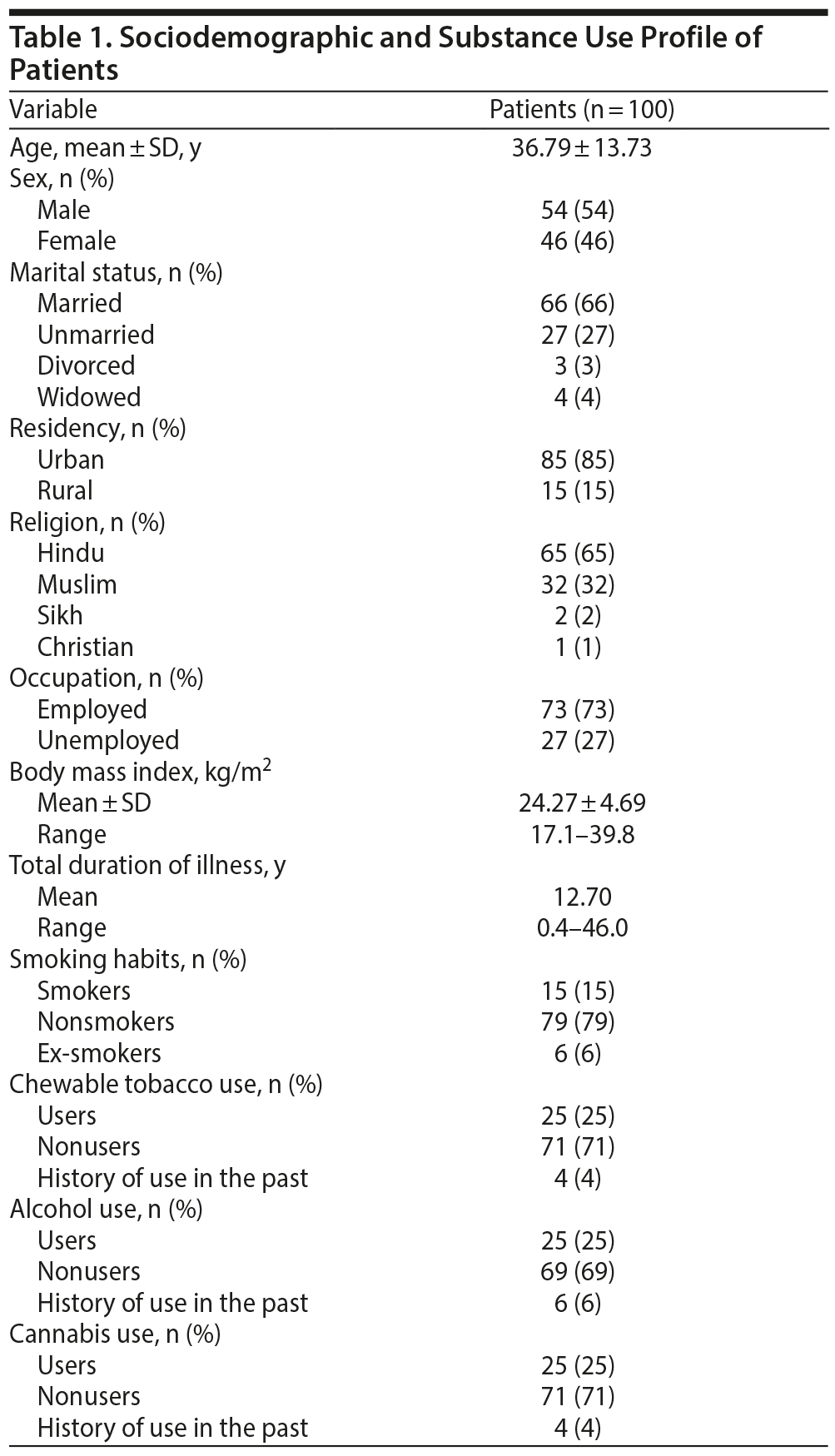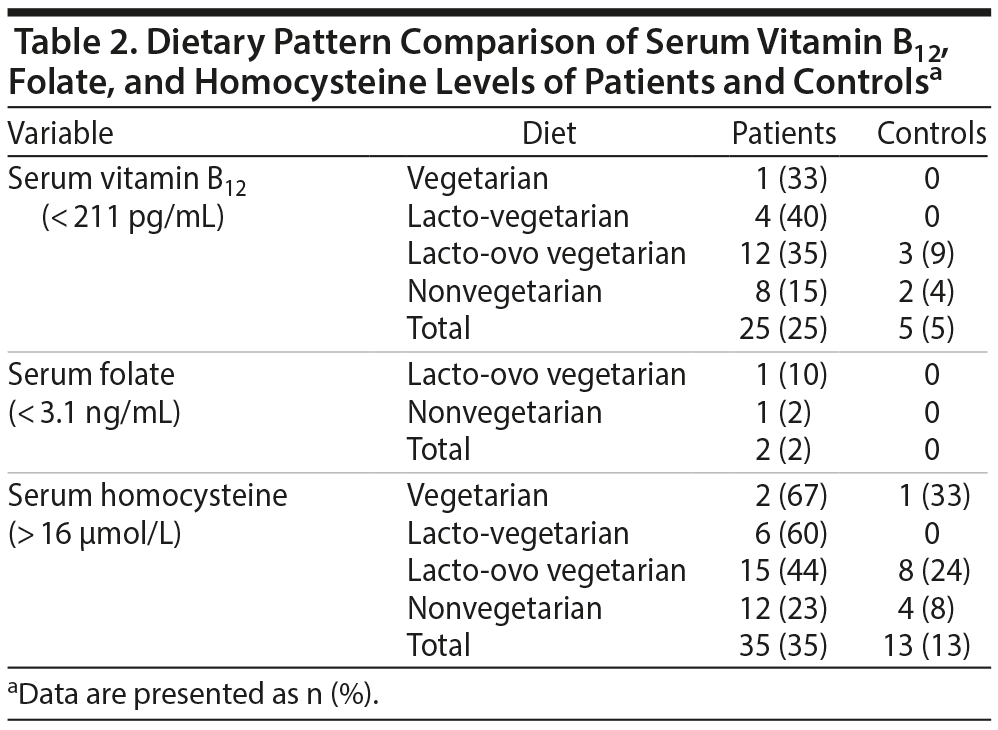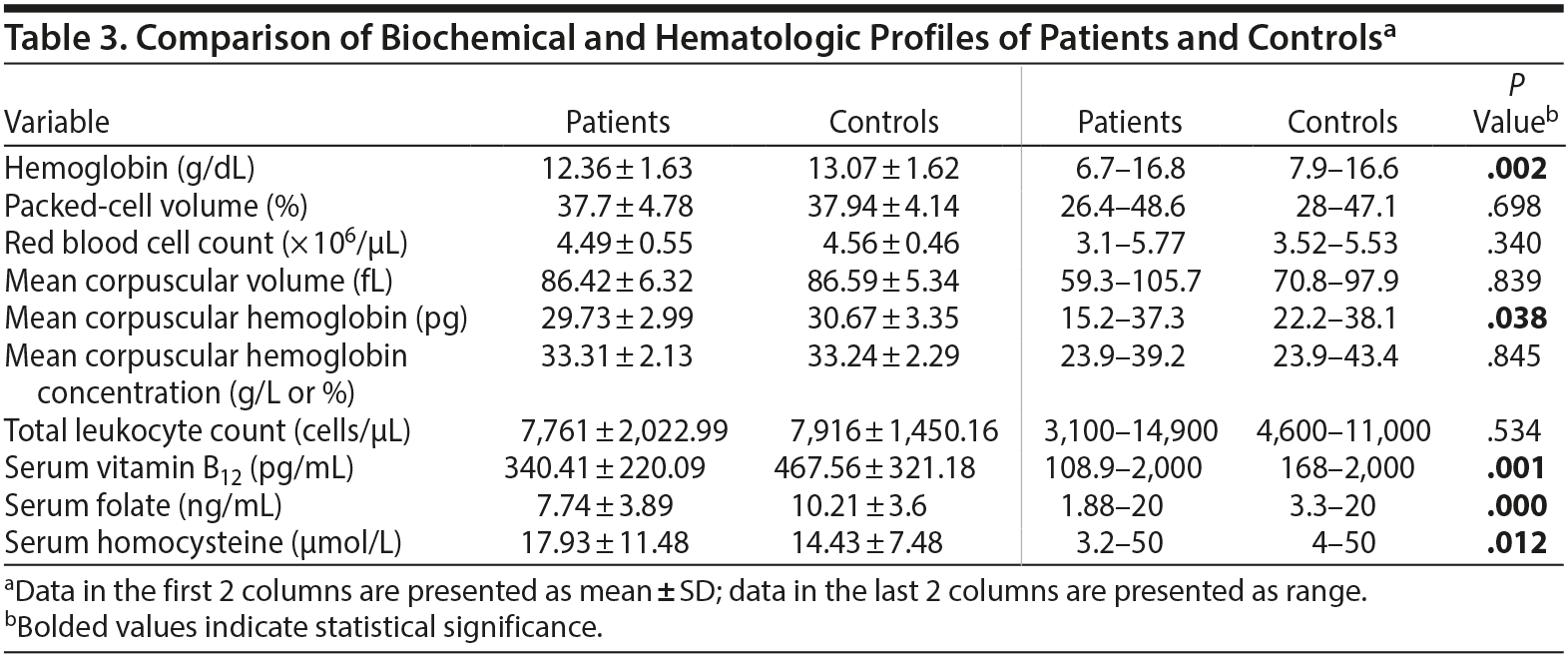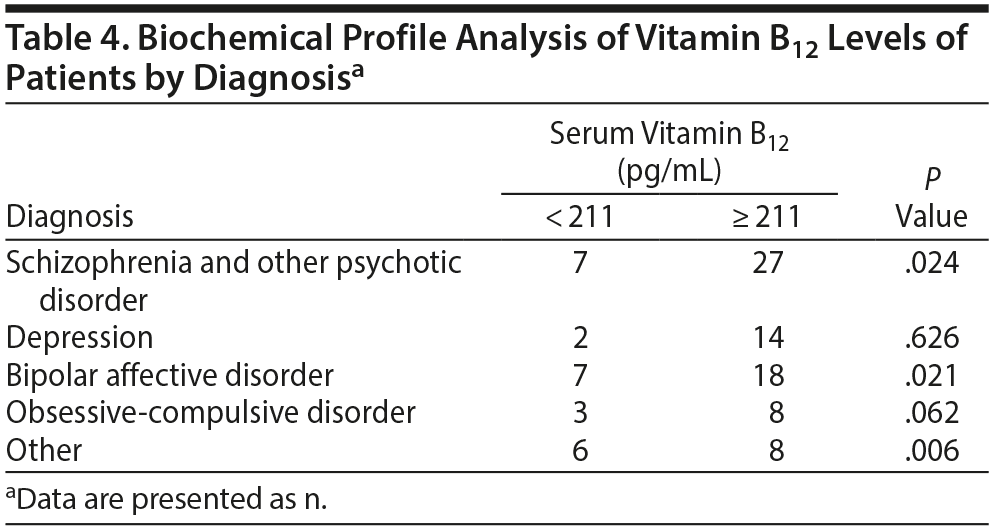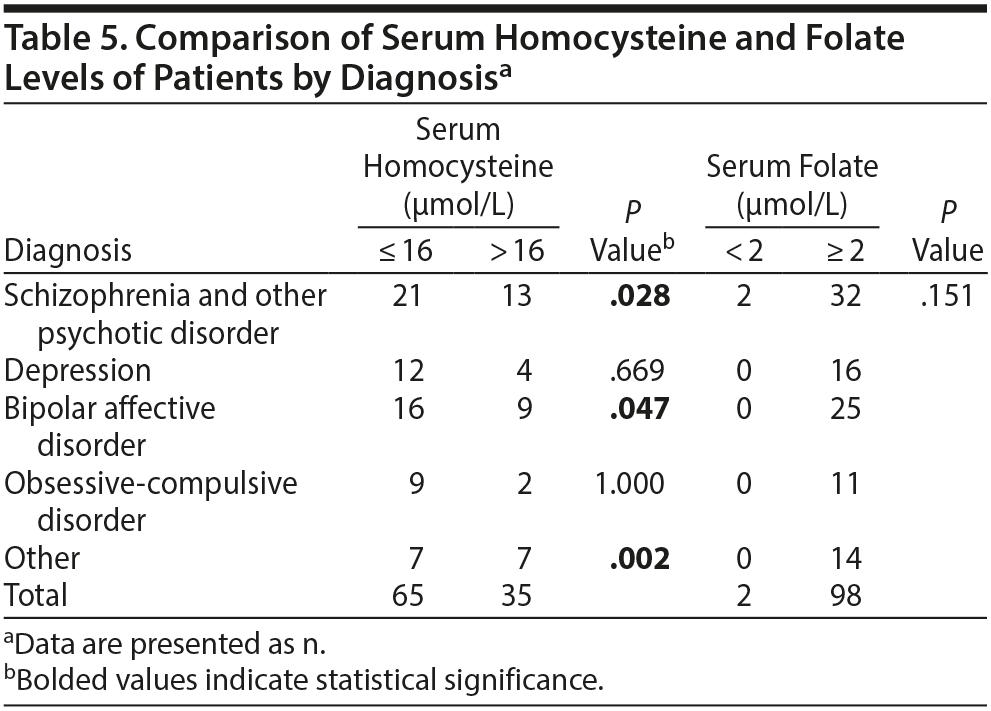Objective: To assess the pattern of serum folate and vitamin B12 levels in psychiatric inpatients compared with nonpsychiatric controls.
Methods: An observational cross-sectional study was conducted with 100 psychiatric inpatients diagnosed with psychiatric illness for the first time per ICD-10 criteria and their age-matched caregivers at a super-specialty center in northern India (from January 1, 2012, to December 31, 2012). Complete blood counts and serum levels of vitamin B12, folate, and homocysteine were measured in all patients and caregivers, who were sharing the same kitchen as that of the patients.
Results: Twenty-five percent of the patients were found to have low levels of serum vitamin B12, which was significant compared with healthy controls (P < .001). Similarly, the difference in homocysteine levels between the patient and control groups was significant (35% vs 13%, P = .012).
Conclusions: A significant proportion of psychiatric patients were found to be vitamin B12 deficient. In-depth studies are required to establish the cause-effect relationship between vitamin B12 deficiency and psychiatric illness and the effect of vitamin B12 replacement.
ABSTRACT
Objective: To assess the pattern of serum folate and vitamin B12 levels in psychiatric inpatients compared with nonpsychiatric controls.
Methods: An observational cross-sectional study was conducted with 100 psychiatric inpatients diagnosed with psychiatric illness for the first time per ICD-10 criteria and their age-matched caregivers at a super-specialty center in northern India (from January 1, 2012, to December 31, 2012). Complete blood counts and serum levels of vitamin B12, folate, and homocysteine were measured in all patients and caregivers, who were sharing the same kitchen as that of the patients.
Results: Twenty-five percent of the patients were found to have low levels of serum vitamin B12, which was significant compared with healthy controls (P < .001). Similarly, the difference in homocysteine levels between the patient and control groups was significant (35% vs 13%, P = .012).
Conclusions: A significant proportion of psychiatric patients were found to be vitamin B12 deficient. In-depth studies are required to establish the cause-effect relationship between vitamin B12 deficiency and psychiatric illness and the effect of vitamin B12 replacement.
Prim Care Companion CNS Disord 2019;21(5):19m02464
To cite: Sagar R, Aggarwal N, Jose N. A cross-sectional study of serum folate and vitamin B12 levels in psychiatric inpatients. Prim Care Companion CNS Disord. 2019;21(5):19m02464.
To share: https://doi.org/10.4088/PCC.19m02464
© Copyright 2019 Physicians Postgraduate Press, Inc.
aDepartment of Psychiatry, Ayushman Hospital, Dwarka, New Delhi, India
bDepartment of Psychiatry, Lady Hardinge Medical College, New Delhi, India
cDepartment of Psychiatry, SGT Medical College, Hospital and Research Institute, Budhera, Gurgaon, India
*Corresponding author: Nitin Aggarwal, MD, Department of Psychiatry, Lady Hardinge Medical College, Cannaught Pl, New Delhi, Delhi 110001, India ([email protected]).
Vitamin B12 and folate are water-soluble vitamins.1 Both play an important role in the formation of red blood cells and a key role, especially vitamin B12, in the functioning of the brain and nervous system.1 Several psychiatric and neurologic illnesses have been associated with vitamin B12 and folate deficiency, such as mood disorders, dementia, paranoid psychoses, violent behavior, and demyelinating myelopathy.2 Psychiatric manifestations may occur in individuals who have not yet developed hematologic or neurologic abnormalities at the time of presentation.3,4
In addition to causing neuropsychiatric symptoms, vitamin B12 and folate deficiency can lead to hyperhomocysteinemia and methylmalonic acidemia, which can have serious health implications.5,6 Early stage vitamin B12 deficiency may present with subtle and slight cognitive impairments. Hence, early recognition is crucial to prevent irreversible damage.6
Neurologic symptoms due to vitamin B12 deficiency may occur in the absence of anemia in 20%–30% of cases.7 The diagnosis is complicated by the limitations of current assay techniques, as a low serum vitamin B12 level does not always indicate vitamin B12 deficiency and a normal level does not always exclude it. However, individuals with biologically significant vitamin B12 deficiency almost always have elevated blood plasma levels of total homocysteine and methylmalonic acid. Thus, individuals with low or borderline levels of vitamin B12 and elevated levels of homocysteine or methylmalonic acid can be defined as having “metabolically significant” vitamin B12 deficiency.7
It has been asserted that performing vitamin B12 assays in psychiatric patients will enable doctors to treat several disabling diseases that otherwise may end in chronicity.3 Reportedly, several patients’ mental health symptoms have responded dramatically to vitamin B12 and folate replacement.3,4
Racial, religious, ethnic, and socioeconomic heterogeneity of the people in India greatly influences their dietary habits. Vitamin B12 deficiency has been observed to be far more prevalent than expected in India, and a majority of the cases remain undiagnosed.6 The purpose of the present study was to compare serum vitamin B12, folate, and homocysteine levels in patients with psychiatric illness admitted to a psychiatry ward in India and consider the relevance of the relationship between psychiatric illness and vitamin B12 and folate deficiency.
METHODS
A descriptive cross-sectional study (observational type) was conducted in the departments of psychiatry, biochemistry, and pathology of a super-specialty medical center in the National Capital Region of India. The study was conducted with psychiatry inpatients from January 1, 2012, to December 31, 2012, to identify the pattern of serum folate and vitamin B12 levels in patients with psychiatric illness. The study was approved by the institution’s ethics committee. A total of 100 consecutive inpatients, who were diagnosed for the first time with a psychiatric illness per ICD-10 research criteria, and their age-matched (± 2years) caregivers (healthy controls) were recruited for the study after written informed consent was obtained. Exclusion criteria included age < 18 years, having significant comorbid medical illness undergoing or requiring treatment, receiving cobalamin supplementation for at least 3 months’ duration, and not providing consent. A semi-structured form was used to obtain relevant medical and dietary history. Complete blood counts and serum vitamin B12 and folate levels were measured in all patients and their caregivers, who were sharing the same kitchen as that of the patients. Serum homocysteine was also measured in both groups. Cutoff values of serum vitamin B12, folate, and homocysteine levels were set per laboratory standards, which are calibrated regularly. Both groups were compared and analyzed on appropriate tests of significance using IBM SPSS Statistics version 16.0 (IBM Corp, Armonk, New York).
RESULTS
A total of 200 subjects (100 patients and 100 controls) were recruited. Sociodemographic and substance use profiles of the patients are shown in Table 1.
Dietary Habits
The patient sample consisted of 3 vegetarians, 10 lacto-vegetarians, 34 lacto-ovo vegetarians, and 53 nonvegetarians, while the control group had comparable values of 3 vegetarians, 11 lacto-vegetarians, 34 lacto-ovo vegetarians, and 52 nonvegetarians (Table 2). Table 3 shows a comparison of the biochemical and hematologic profiles of patients and controls.
Vitamin B12
The mean vitamin B12 level of the patients was 340.41 pg/mL. Twenty-five (25%) of the patients and 5 (5%) of the controls had low serum B12 levels. The difference in serum vitamin B12 levels between patients and controls was statistically significant (P< .05).
Folate
The mean serum folate level in our sample was 7.74 ng/mL. Two (2%) of the patients and none of the controls had low serum folate levels.
Homocysteine
The mean homocysteine level was 17.93 µmol/L. A higher frequency of greater than normal levels of homocysteine was found in patients compared with controls (35% vs 13%, respectively), which was statistically significant (P < .05).
Hematologic Parameters
The mean ± SD hemoglobin level of patients was 12.36 ± 1.63 g/dL, which was statistically significant compared with controls (P = .002; range, 6.7–16.8 g/dL). Mean ± SD corpuscular hemoglobin was 29.73 ± 2.99 pg, which was also statistically significant (P = .038, Table 3).
Table 4 shows that 25 patients had low vitamin B12 levels. Seven of 34 (21%) patients with schizophrenia and other psychotic disorder had low vitamin B12 levels, which was statistically significant (P < .05). Seven of 25 (28%) patients with bipolar affective disorder had low vitamin B12 levels (P < .05, statistically significant), and 6 of 14 (42.86%) patients categorized with other psychiatric disorders including somatoform disorder and organic dissociative disorder also had low vitamin B12 levels (P < .05, statistically significant). Two patients (both men) with low serum folate levels were diagnosed with schizophrenia and other psychotic disorder (Table 5).
Table 6 provides a comparison of serum B12 levels with various parameters. The mean ± SD hemoglobin level of patients was 10.7 ± 1.4 g/dL, which was highly statistically significant compared with the control group (P < .001). The packed-cell volume of patients was 33.9% ± 3.7%, which compared with the control group was a highly significant difference (P < .001). The red blood cell count of patients was 4.01 ± 0.50 × 106/µL, which was highly statistically significant (P < .001) compared with the control group. Finally, the mean ± SD corpuscular hemoglobin concentration of patients was 32.4% ± 2.0%, and the difference between the control group was statistically significant (P < .05).
DISCUSSION
The population of the Indian subcontinent is > 1 billion, most of whom consume a diet low in cobalamin. Despite how common cobalamin deficiency is in India, this problem has received little attention. The national strategies for improving micronutrient intake do not include cobalamin, and a search of MEDLINE indicated that vitamin A, iron, zinc, and iodine are considered the micronutrients of interest by the Indian medical community.8
In this cross-sectional study, we found a high prevalence of low serum vitamin B12 levels (25%) among admitted psychiatric patients compared with other studies.9,10 A study by Khanduri et al11 showed that almost half of the healthy subjects had subnormal levels of cobalamin or folate. The authors11 found that cobalamin deficiency is 5 times more common than folate deficiency, which is consistent with our findings and contrary to the common perception that folate deficiency is widespread. In contrast, a study by Lerner et al12 in 224 newly admitted patients in a psychiatric ward found no significant difference in cobalamin levels compared with controls. However, that study12 found approximately 30% of patients had low folate values compared to 2.5% in the control group (P < .0001), and mean folate levels were higher in controls (P < .0001). It is well documented that racial and ethnic factors influence the levels and metabolism of these vitamins.13,14
Studies1,15,16 have found folate and vitamin B12 to be directly correlated and folate inversely correlated with homocysteine, which was also a finding in our study. While some found no correlation between vitamin B12 and homocysteine,15 we found a strong correlation between vitamin B12 and homocysteine most likely because their metabolism is linked.
In our study, the prevalence of vitamin B12 deficiency in both patients and controls was on the higher end of the prevalence range found in the general population. However, only 2% of patients and no controls had low serum folate levels (low folate levels in the general population may range from 4%–18% and vitamin B12 from 3%–13%17).
Currently, there are no agreed-upon universal cutoff values for the normal range of serum levels of vitamin B12.18 It is possible that the higher prevalence of serum vitamin B12 levels may have been aided by the manufacturer’s vitamin B12 testing kit recommendations, which had reference values based on different population characteristics. The high prevalence of low vitamin B12 levels in our study could have been a result of differences in genetics or patients’ eating habits or dietary deficiencies, which could have been a consequence of their mental illness.19,20 Use of anticonvulsants is also a possibility.21 Other possible causes of the difference between our study and others could be that we did not include patients aged < 18 years. Thus, if the age group <18 years is included, the prevalence of vitamin deficiency may increase. Ethnic variations, which affect vitamin levels, could be another factor.
A high prevalence of subjects with low vitamin B12 levels was found in vegetarians. Our findings are supported by Wokes et al,22 who systematically compared a group of US, Dutch, and British vegetarians with nonvegetarians from those same countries and found that many of the vegetarians had significantly lower vitamin B12 concentrations than did the nonvegetarians.
Since the neuropsychiatric symptoms frequently appear before the hematologic manifestations,4,23 we support the approach that the cobalamin level should be based not only on hematologic findings but also on a clinical neuropsychiatric picture of cobalamin deficiency.24
We found that low serum folate and vitamin B12 levels were not correlated to red blood cell count, hematocrit, mean corpuscular hemoglobin concentration, mean corpuscular volume, mean corpuscular hemoglobin, or hemoglobin. In our study, of 25 patients with low vitamin B12 levels, only 11 (44%) had macrocytosis. Thirty-seven percent of the subjects had low hemoglobin (< 12 g/dL), of whom 25 patients had low vitamin B12. While only 5% of controls had macrocytosis (P = .002), these observations are consistent with research25 that found that low serum folate or red blood cell count cannot be predicted by hematologic indices. Other studies12,26 found that anemia or macrocytosis may be absent in up to 28% of patients with vitamin B12 deficiency and related neuropsychiatric disorders. The explanation for this finding may be that primary folate and vitamin B12 deficiency may result in macrocytic anemia characterized by increased mean corpuscular volume, decreased red blood cell count, and low hemotocrit, but other causes of macrocytic anemia may include alcohol abuse, liver disease, hypothyroidism, and drugs such as phenytoin. Not all of these conditions involve folate or vitamin B12 deficiency. Consequently, a patient with macrocytic anemia may not necessarily be folate or vitamin B12 deficient, and, conversely, folate- and vitamin B12–deficient patients may not have macrocytic anemia.12
We suggest that neuropsychiatric disorders due to cobalamin deficiency occur commonly in the absence of anemia or an elevated mean cell volume and that measurements of serum homocysteine are useful in the diagnosis of these patients, which is also supported by Lerner et al.12
In our study, 2 of 35 (5.88%) schizophrenia patients versus no controls had serum folate deficiency, a finding similar to that of Bottiglieri et al.27 On the other hand, no difference in folic acid status among different psychiatric disorders versus healthy controls was found in other research.28
In our study, 2 of 16 (12.5%) patients with depression had low vitamin B12 levels, which was nonstatistically significant (P = .626). Four of 16 (25%) patients with depression had high homocysteine levels, which was nonstatistically significant (P = .669). None of the patients with depression had folate deficiency. Bottiglieri et al27 found that only 8% of depressed patients had subnormal vitamin B12 levels, while 30.4% of patients had red blood cell folate levels below the normal range (which is quite higher than that found in our study). Similarly, Lerner et al12 found a positive correlation between low folate levels and depression, which is also in contrast to our finding.
Several studies29,30 have examined serum levels of cobalamin and folate among middle-aged psychiatric inpatients and described a relatively low prevalence of below-normal cobalamin levels (1%–10%). Other studies31–33 have reported that between 12% and 30% of inpatients with depression had folate deficiency. Tiemeier et al34 found that the association of vitamin B12 and folate with depressive disorders may have a different mechanism: vitamin B12 may be causally related to depression, whereas the relation with folate is due to physical comorbidity. Abou-Saleh and Coppen35 reported that a depressed state may contribute to vitamin deficiencies through decreased appetite and dietary intake, poor food choices, and gastrointestinal disturbance that may decrease absorption of vitamins in the gut.
The association of vitamin B12 and folate with bipolar disorder has been evaluated. In a case report36 of short-duration episodes of mania, a patient achieved clinical remission while receiving vitamin B12 alone, suggesting that vitamin B12 deficiency was the most likely cause of her psychiatric disorder. In our study, 7 of 25 (28%) patients with bipolar disorder were found to have low vitamin B12 levels, which was statistically significant (P = .021.). Nine of 18 patients (50%) with bipolar affective disorder were found to have elevated serum homocysteine levels, while none had low serum folate levels. Our findings could also raise the hypothesis of different neurobiological mechanisms underlying mood disorders and the importance of vitamin B12 in their genesis.
Among various psychiatric disorders, obsessive-compulsive disorder (OCD) in relation to vitamin B12 deficiency has not been described. In our study, 3 of 11 (27%) patients with OCD were found to have low vitamin B12 levels, which was close to statistical significance (P = .062). This finding is supported by Hermesh et al,37 who found 6 of 30 patients (20%) in the OCD group had abnormally low levels of vitamin B12, suggesting that low vitamin B12 levels could be either the cause or consequence of OCD. Sharma and Biswas38 reported the case of a middle-aged man presenting with OCD, low serum cobalamin, and a positive family history of vitamin B12 deficiency who responded well to methylcobalamin replacement. Two of 11 patients (18.18%) with OCD were found to have elevated homocysteine levels, which was not statistically significant.38
A limitation of this study was that we measured serum folate as opposed to red blood cell folate; the latter may be a better predictor of an individual’s folate status.39 For example, serum folate, unlike red blood cell folate, is sensitive to acute dietary status (eg, fasting), concomitant medications, and time of day when blood levels are drawn. Such factors were not corrected for in this study. Since folate and vitamin B12 levels are not predicted by red cell indices, our results, taken in context of prior-mentioned research,23 raise the question of whether clinicians assessing patients with psychiatric illnesses should consider obtaining baseline folate and vitamin B12 levels instead of relying on complete blood count measurements alone. Such assessment could prove particularly important with regard to patients with poor nutritional status or alcoholism or those who have been refractory to standard antidepressant regimens. There are limited data regarding the cost-effectiveness of this type of laboratory screening of psychiatric patients in clinical practice.
Anfinson and Kathol40 suggest that although most of these investigations are clinically insignificant and do not affect treatment or outcome, certain populations may benefit from laboratory screening. These populations include the elderly, people of lower socioeconomic status, patients in state hospitals, patients with substance abuse or self-neglect histories, and patients with organic mental disorders.40 Pending more direct assessment of cost-effectiveness, it may be reasonable to assess folate and vitamin B12 levels in depressed patients who have comorbid conditions known to be associated with folate or vitamin B12 deficiency such as pregnancy, malabsorption syndromes, dementia, alcoholism, and use of phenytoin and in patients who have been refractory to standard antidepressant treatment.
Diagnostic algorithms have consistently stressed the value of always including clinical data to improve the pretest probability that test results indicating low serum cobalamin or serum folate concentrations support the diagnosis of a deficiency of these vitamins, as these tests have inherent limitations in sensitivity and specificity. Further studies are needed to address whether detection and treatment of vitamin deficiencies will favorably alter psychiatric outcomes in a cost-effective manner and to better identify populations that may benefit from screening for these deficiencies.
CONCLUSION
We found a significant proportion of psychiatric patients to be vitamin B12 deficient. So, replacement of vitamin B12 might help in the management of psychiatric inpatients. Further, serum levels of vitamin B12 should be investigated frequently; this testing is usually neglected in resource-limited developing countries like India. In-depth studies are required to establish the cause-effect relationship between vitamin B12 deficiency and psychiatric illness and the effect of vitamin B12 replacement.
Submitted: March 27, 2019; accepted May 22, 2019.
Published online: October 10, 2019.
Potential conflicts of interest: None.
Funding/support: None.
REFERENCES
1. National Institute of Health Office of Dietary Supplements. Vitamin B12 Fact Sheet for Consumers. NIH website. https://ods.od.nih.gov/factsheets/VitaminB12-Consumer/.
2. Dommisse J. Subtle vitamin-B12 deficiency and psychiatry: a largely unnoticed but devastating relationship? Med Hypotheses. 1991;34(2):131–140. PubMed CrossRef
3. Shulman R. Vitamin B-12 deficiency and psychiatric illness. Br J Psychiatry. 1967;113(496):252–256. PubMed CrossRef
4. Hutto BR. Folate and cobalamin in psychiatric illness. Compr Psychiatry. 1997;38(6):305–314. PubMed CrossRef
5. Bottiglieri T. Folate, vitamin B12, and neuropsychiatric disorders. Nutr Rev. 1996;54(12):382–390. PubMed CrossRef
6. Arora S, Singh B, Gupta VK, et al. Burden of vitamin B12 deficiency in urban population in Delhi, India: a hospital based study. Int J Pharma Bio Sci. 2011;2(1):521–528.
7. Clarke R, Grimley Evans J, Schneede J, et al. Vitamin B12 and folate deficiency in later life. Age Ageing. 2004;33(1):34–41. PubMed CrossRef
8. Vijayaraghavan K. Strategies for control of micronutrient malnutrition. Indian J Med Res. 1995;102:216–222. PubMed. 10.1016/j.colsurfa.2018.02.046
9. Gielchinsky Y, Elstein D, Green R, et al. High prevalence of low serum vitamin B12 in a multi-ethnic Israeli population. Br J Haematol. 2001;115(3):707–709. PubMed CrossRef
10. Figlin E, Chetrit A, Shahar A, et al. High prevalences of vitamin B12 and folic acid deficiency in elderly subjects in Israel. Br J Haematol. 2003;123(4):696–701. PubMed CrossRef
11. Khanduri U, Sharma A, Joshi A. Occult cobalamin and folate deficiency in Indians. Natl Med J India. 2005;18(4):182–183. PubMed
12. Lerner V, Kanevsky M, Dwolatzky T, et al. Vitamin B12 and folate serum levels in newly admitted psychiatric patients. Clin Nutr. 2006;25(1):60–67. PubMed CrossRef
13. Antony AC. Prevalence of cobalamin (vitamin B-12) and folate deficiency in. Am J Clin Nutr. 2001;74(2):157–159. PubMed CrossRef
14. Carmel R, Green R, Jacobsen DW, et al. Serum cobalamin, homocysteine, and methylmalonic acid concentrations in a multiethnic elderly population: ethnic and sex differences in cobalamin and metabolite abnormalities. Am J Clin Nutr. 1999;70(5):904–910. PubMed CrossRef
15. Hughes K, Ong CN. Homocysteine, folate, vitamin B12, and cardiovascular risk in Indians, Malays, and Chinese in Singapore. J Epidemiol Community Health. 2000;54(1):31–34. PubMed CrossRef
16. Miner SES, Evrovski J, Cole DEC. Clinical chemistry and molecular biology of homocysteine metabolism: an update. Clin Biochem. 1997;30(3):189–201. PubMed CrossRef
17. Jacques PF, Selhub J, Bostom AG, et al. The effect of folic acid fortification on plasma folate and total homocysteine concentrations. N Engl J Med. 1999;340(19):1449–1454. PubMed CrossRef
18. de Benoist B; WHO. Conclusions of a WHO Technical Consultation on folate and vitamin B12 deficiencies. Food Nutr Bull. 2008;29(suppl):S238–S244. PubMed
19. Silver H. Vitamin B12 levels are low in hospitalized psychiatric patients. Isr J Psychiatry Relat Sci. 2000;37(1):41–45. PubMed
20. Streiff RR. Anemia and nutritional deficiency in the acutely ill hospitalized patients. Med Clin North Am. 1993;77(4):911–918. PubMed CrossRef
21. Karabiber H, Sonmezgoz E, Ozerol E, et al. Effects of valproate and carbamazepine on serum levels of homocysteine, vitamin B12, and folic acid. Brain Dev. 2003;25(2):113–115. PubMed CrossRef
22. Wokes F, Badenoch J, Sinclair HM. Human dietary deficiency of vitamin B12. Am J Clin Nutr. 1955;3(5):375–382. PubMed
23. Evans DL, Edelsohn GA, Golden RN. Organic psychosis without anemia or spinal cord symptoms in patients with vitamin B12deficiency. Am J Psychiatry. 1983;140(2):210–221. PubMed CrossRef
24. Green R, Kinsella LJ. Current concepts in the diagnosis of cobalamin deficiency. Neurology. 1995;45(8):1435–1440. PubMed CrossRef
25. Kale A, Joshi S, Naphade N, et al. Opposite changes in predominantly docosahexaenoic acid (DHA) in cerebrospinal fluid and red blood cells from never-medicated first-episode psychotic patients. Schizophr Res. 2008;98(1–3):295–301. PubMed CrossRef
26. Stabler SP, Allen RH, Savage DG, et al. Clinical spectrum and diagnosis of cobalamin deficiency. Blood. 1990;76(5):871–881. PubMed
27. Bottiglieri T, Laundy M, Crellin R, et al. Homocysteine, folate, methylation, and monoamine metabolism in depression. J Neurol Neurosurg Psychiatry. 2000;69(2):228–232. PubMed CrossRef
28. Reif A, Pfuhlmann B, Lesch KP. Homocysteinemia as well as methylenetetrahydrofolate reductase polymorphism are associated with affective psychoses. Prog Neuropsychopharmacol Biol Psychiatry. 2005;29(7):1162–1168. PubMed CrossRef
29. Carney MWP. Serum folate values in 423 psychiatric patients. BMJ. 1967;4(5578):512–516. PubMed CrossRef
30. Elsborg L, Hansen T, Rafaelsen OJ. Vitamin B12 concentrations in psychiatric patients. Acta Psychiatr Scand. 1979;59(2):145–152. PubMed CrossRef
31. Oxnard CE, Smith WT. Vitamin-B12 deficiency in psychiatry. Lancet. 1967;289(7482):161. CrossRef
32. Alpert JE, Fava M. Nutrition and depression: the role of folate. Nutr Rev. 1997;55(5):145–149. PubMed CrossRef
33. Alpert JE, Mischoulon D, Nierenberg AA, et al. Nutrition and depression: focus on folate. Nutrition. 2000;16(7–8):544–546. PubMed CrossRef
34. Tiemeier H, van Tuijl HR, Hofman A, et al. Vitamin B12, folate, and homocysteine in depression: the Rotterdam Study. Am J Psychiatry. 2002;159(12):2099–2101. PubMed CrossRef
35. Abou-Saleh MT, Coppen A. The biology of folate in depression: implications for nutritional hypotheses of the psychoses. J Psychiatr Res. 1986;20(2):91–101. PubMed CrossRef
36. Gomez-Bernal GJ, Bernal-Perez M. Vitamin B12 deficiency manifested as mania: a case report. Prim Care Companion J Clin Psychiatry. 2007;9(3):238. PubMed CrossRef
37. Hermesh H, Weizman A, Shahar A, et al. Vitamin B12 and folic acid serum levels in obsessive compulsive disorder. Acta Psychiatr Scand. 1988;78(1):8–10. PubMed CrossRef
38. Sharma V, Biswas D. Cobalamin deficiency presenting as obsessive compulsive disorder: case report. Gen Hosp Psychiatry. 2012;34(5):578.e7–578.e8. PubMed CrossRef
39. Carney MWP, Sheffield BF. Serum folic acid and B12 in 272 psychiatric in-patients. Psychol Med. 1978;8(1):139–144. PubMed CrossRef
40. Anfinson TJ, Kathol RG. Screening laboratory evaluation in psychiatric patients: a review. Gen Hosp Psychiatry. 1992;14(4):248–257. PubMed CrossRef
Please sign in or purchase this PDF for $40.00.
Save
Cite
